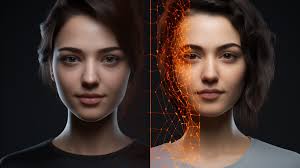First things first, let’s clear up what we’re not talking about. An AI avatar is not a Snapchat filter that gives you puppy ears. It’s not the pre-rendered character you control in a video game. And it’s certainly not a simple, static 2D cartoon. Instead, we are discussing AI Avatars, which represent a significant leap in digital representation.

So, what is it?
Imagine a digital human, so lifelike you can see the subtle crinkles around their eyes when they smile. They can speak in a natural, human-sounding voice, with perfect lip-syncing to the words. They can convey empathy, authority, or excitement through nuanced facial expressions. This entity has no physical body, but it has a face and a voice, and it can be programmed to deliver any message, in any language.
AI Avatars have the potential to transform how we interact online, bridging the gap between digital and human experiences.
At its core, an AI avatar is a form of synthetic media—a digital creation born from a powerful cocktail of technologies: Generative AI to create the visual form, Deep Learning to understand human expression, Computer Vision to map facial movements, and advanced Speech Synthesis to give it a voice. The result is a virtual spokesperson, teacher, or assistant that is both incredibly versatile and endlessly patient.
The Magic Behind the Mask: How AI Avatars Are Created
The process of creating these avatars feels a bit like magic, but it’s really a sophisticated, step-by-step technical dance. Let’s demystify it.
Step 1: The Foundation – Model Training
Before an AI can create a realistic human, it needs to learn what a human is. This is where the heavy lifting happens. The underlying AI model is trained on thousands—sometimes millions—of hours of video footage of real people speaking. It doesn’t just learn what a mouth looks like; it learns the countless ways a mouth moves to form every possible syllable and sound (a field known as visemes). It studies eyebrow raises, slight head tilts, and subtle smirks, building a vast internal library of human expression. Some avatars are “archetypes”—pre-built from this general data—while others are custom clones, created by training specifically on video of one individual.
Step 2: The Blueprint – Script & Voice
Once the model is trained, it needs a script. This is the human part. You, the user, simply type out what you want the avatar to say. This text is then fed into a powerful Text-to-Speech (TTS) engine. This isn’t the robotic, monotone TTS of yesteryear. Modern systems can produce stunningly natural speech, with intonation, rhythm, and emotion. You can often choose from hundreds of voices across different ages, accents, and genders. For an even more personal touch, some platforms allow you to “clone” a specific person’s voice from a clean audio sample.
Step 3: The Animation – Bringing It to Life
This is where the magic truly becomes visible. The AI now takes the generated audio file and its deep understanding of human movement and combines them. It meticulously animates the avatar model, frame by frame, to match the speech. The lips move in perfect sync with the words, the head turns naturally for emphasis, and the face reflects the intended emotion of the script. The final output is a seamless, high-definition video of a digital person delivering your message as if they were in the room with you.
More Than a Gimmick: 5 Powerful Applications of AI Avatars

It’s easy to write this off as a cool tech demo, but the real power of AI avatars lies in their profound practical applications. They are solving real-world business and communication problems right now.
1. Corporate Training & eLearning
For large, especially global, organizations, training is a massive logistical and financial challenge. An AI avatar solution is a game-changer. A single training module can be created with a polished, professional avatar and then instantly translated into dozens of languages, with the avatar’s lip movements adjusted to match the new language. Need to update a compliance policy? Simply change the script and regenerate the video. No need to re-shoot, re-hire, or re-schedule. The consistency, scalability, and cost savings are immense.
2. Marketing & Personalized Sales Videos
How do you cut through the noise of generic email blasts? Imagine sending a video email to a prospect where the avatar says, “Hi [Prospect’s Name], I was looking at your company’s work in [Their Industry] and thought this solution might be a perfect fit.” This level of personalization at scale was previously impossible. AI avatars allow marketers to create dynamic, engaging video content that feels personal and direct, dramatically increasing engagement and conversion rates.
3. 24/7 Customer Service Representatives
While text-based chatbots are common, they can feel impersonal and frustrating. AI avatars are the next evolution. Imagine visiting a help page and being greeted by a friendly, empathetic digital face that can guide you through troubleshooting steps, answer FAQs, and even detect frustration in your tone (via integrated sentiment analysis). They never get tired, they’re always available, and they provide a more human-centered interaction than pure text.
4. Entertainment & Social Media Content
The world of content creation is being revolutionized. YouTubers and educators can now produce high-quality, scripted videos without ever needing to be on camera. They can create an avatar persona, write a script, and generate the video. This is a boon for creators who are camera-shy or who want to produce content in multiple languages to reach a global audience without the cost of human translators and presenters.
5. Accessibility & Language Localization
The impact of this technology on accessibility is profound. It can provide video content for individuals who are more auditory/visual learners or who have reading difficulties. Furthermore, it demolishes language barriers. An educational nonprofit can create a single piece of vital content and distribute it globally in the native language of every community it serves, complete with a relatable presenter, all for a fraction of the traditional cost of human translation and video production.
The Top Contenders: A Look at Popular AI Avatar Platforms

The market for this technology is exploding. Here’s a quick look at some of the leading platforms making this technology accessible.
- Synthesia: Often considered the industry leader, Synthesia is widely popular for corporate training. It offers a wide range of hyper-realistic, pre-built avatars and a very user-friendly, no-code interface. You type your script, choose an avatar and voice, and it generates a professional video in minutes.
- HeyGen (formerly Movio): A strong competitor, HeyGen is known for its high quality and ease of use. It also offers a powerful feature for translating your existing videos—using your own voice—into other languages, with perfectly synced lip movements.
- Elai.io: This platform offers a good balance of features, including the ability to create avatars from a photo and a strong focus on templated workflows for different types of videos (like news updates or product explainers).
- D-ID: If you’re more technically inclined or interested in real-time interaction, D-ID is a fascinating player. They specialize in creating “talking heads” from still photos, which opens doors for interactive AI experiences.
The best choice depends on your needs: ease of use, the need for a custom avatar, budget, and specific features like real-time interaction.
Navigating the Ethical Landscape: The Challenges of Deepfakes and Misinformation
We can’t discuss this powerful technology without addressing the elephant in the room: its potential for misuse. The same technology that can create a friendly teacher can also be used to create deepfakes—maliciously fabricated videos designed to spread misinformation, commit fraud, or harass individuals.
This is a serious and valid concern. The ability to make a world leader, a celebrity, or even a private citizen appear to say or do something they never did poses a real threat to trust and truth.
So, what’s the solution? The answer isn’t to halt progress, but to build responsibly.
- Ethical Use & Consent: Reputable platforms have strict terms of service prohibiting the creation of harmful content and require explicit consent to create an avatar of a real person.
- Digital Watermarking: Many are developing invisible digital watermarks that can help identify a video as AI-generated, creating a layer of transparency.
- Public Education: The most powerful tool is awareness. As a society, we must become more media-literate, understanding that seeing a video is no longer absolute proof.
The development of this technology must be paired with a strong ethical framework and robust safeguards.
The Future is Synthetic: What’s Next for AI Avatars?
We are only at the beginning of this journey. The avatars of the near future will make today’s versions look like cave paintings.
- Real-time Interaction: The next frontier is moving from pre-rendered videos to live, interactive avatars. Imagine having a natural, real-time conversation with a digital customer service agent or a virtual tutor that can adapt its explanations on the fly based on your questions.
- Hyper-Personalization: Avatars will be able to pull from your data (with permission) to tailor their message specifically to you, referencing your past purchases, your location, or your stated preferences.
- Emotional Intelligence: With integrated emotion recognition AI, future avatars will be able to analyze a user’s facial expression or tone of voice and respond with appropriate empathy or concern.
- Integration with VR/AR: In the burgeoning metaverse, AI avatars will be our guides, companions, and colleagues. They will be the lifelike inhabitants of digital worlds, serving as hosts, trainers, and even friends.
Your Digital Presence, Reimagined
AI powered avatars are far more than a technological novelty. They are a practical, powerful tool that is already enhancing how we learn, shop, and access information. They represent a fundamental shift in digital communication, offering a bridge between the scalability of machines and the relatability of humans.
As the lines between our physical and digital lives continue to blur, these synthetic humans are poised to become an integral part of our world. They are the teachers who never tire, the global spokespeople who speak every language, and the patient assistants who are always there to help.
The future of interaction isn’t just human-to-human or human-to-machine. It’s human-to-digital-human, and that future is already here.
Ready to experiment? Which of the applications above excites you the most—personalized marketing, accessible education, or something else entirely? Share your thoughts or questions in the comments below!

0 Comments